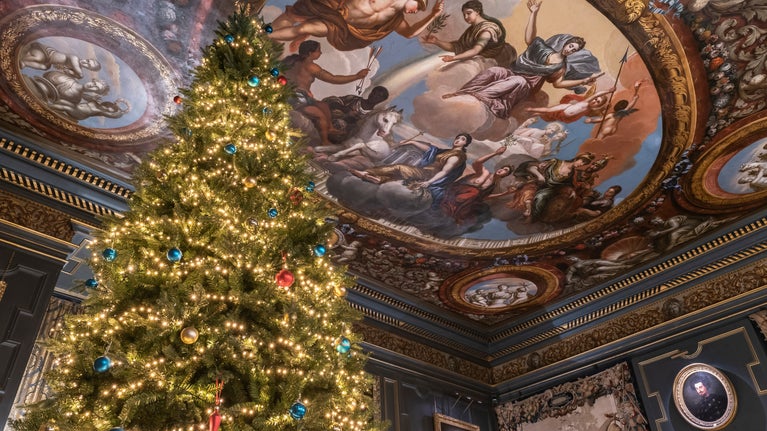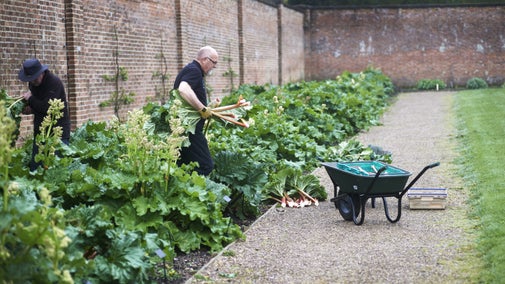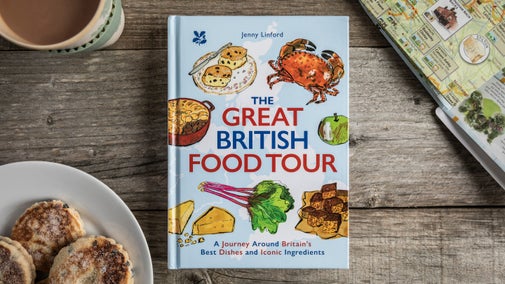
Immerse yourself in history
Meet people from the centuries gone by, learn about the unique artworks in our care and understand more about historic traditions.

Fruit and vegetable growing has long been a tradition in gardens, allotments and growing spaces, but do you know where your ingredients originally came from? From the Victorian ‘rhubarb triangle’ in Yorkshire to the ancient potatoes of Peru, discover more about the history of our seasonal food.
Apples were probably carried by merchants down trade routes and by Roman armies across Europe, leaving seeds as they travelled. Today, there are more than 7,000 different varieties of apples suitable for eating, cooking and cider making. Most apple trees will only produce fruit if their flowers have been pollinated with pollen from the flowers of a different apple variety.
Asparagus originates from the eastern Mediterranean and has been cultivated for thousands of years. The name comes from the Persian word asparag (meaning shoot), and this gradually changed to sparagus, then asparagus. The former gave rise to the popular folk name of sparrow grass, which is still used in some areas today.
Garden carrots are a domesticated form of wild carrot, native to Iran and Afghanistan. Like many of our edible crops, carrots have changed greatly through centuries of cultivation. Wild carrots were much smaller and purple in colour. It wasn’t until around the 16th century that Dutch growers favoured orange carrots through selective breeding.
Carrots arrived in Britain in Elizabethan times and quickly became a popular part of the diet. We now eat around 10 billion carrots a year. Carrots are considered a ‘superfood’ due to their rich source of beta-carotene and vitamins.
Damsons got their name from Damascus where they are said to have been bred and eaten by ancient Romans. However, they are closely related to the bullace, a small tree that grows wild in Britain. There are many different varieties of this tree, including ‘Merryweather’, which was raised in Nottingham during the early 20th century.
Their rich sharp flavour makes them excellent for jams and puddings and it’s thought that their deep colour was once used to make purple dye. Some varieties including 'Prune Damson' can be dried to make prunes.

We've been growing sage, rosemary, bay and thyme for so long that it's easy to forget they originated in the Mediterranean. Many herbs arrived with the Romans and were soon cultivated in gardens for culinary and medicinal use. They were popular during medieval times and were often used in dishes for special occasions.
The humble leek has a long and distinguished history in Britain. Its wild ancestors grow in the eastern Mediterranean but, like many garden crops, centuries of selection and cultivation have transformed its appearance and flavour. Leeks were probably introduced to our shores by the Romans to liven up the native diet.
How the leek became the national symbol of Wales is uncertain, but it is thought to go back to Celtic tradition, long before its association with St David’s Day. There are now hundreds of varieties of leeks and it’s a favourite with competitive amateur growers. The world record currently stands at over 10.7kg in weight.
Parsley is a member of the carrot family and native to the Mediterranean region. The cultivation and use of parsley goes back into the mists of time, but it's known to have been popular with the Romans and Greeks. Like other useful plants, parsley spread around the world with the movement of people, and it’s now used in a wide range of cuisines as a garnish or to add flavour.
The humble potato originated from South America and the Inca people of Peru grew potatoes from at least 5,000 BC. The vegetable was only introduced to Europe in the late 16th century. Potatoes grown in the UK are usually classified as earlies or main crop, depending on when they are harvested. Earlies are also called new potatoes and are harvested when small and young.

The origin of cultivated rhubarb is a mystery, but it's thought to be a hybrid of wild plant species native to Central Asia and Siberia. Historically, rhubarb was valued for its medicinal properties long before it was used in cooking. It was grown for thousands of years in China, where it was used for its antibacterial and anti-inflammatory properties.
Rhubarb reached Europe in the 14th century and became a very valuable commodity alongside other traded goods such as silk and pearls. Its popularity grew rapidly in the late 18th and 19th centuries as better varieties were developed. Sugar, which was used to sweeten it, had also became less expensive by this time.
The Victorians discovered that growing rhubarb in dark sheds produced the finest tender stalks, which were harvested by torchlight. There was such a high demand for this early 'forced' rhubarb in the UK, that it became big business. It grew so much in one area of West Yorkshire, that it became known as the 'rhubarb triangle'.
The rise of colonialism during the 17th century saw the introduction of flavours from East Asia and the trade in spices such as cloves, nutmeg, cinnamon and ginger. Initially, their scarcity made them very expensive and only enjoyed by wealthy diners. Gradually, through a combination of wider cultivation and improved transport, the price of spices fell and by Victorian times, many spices were readily available.
Sweetcorn is a close relation of maize but, while maize is left to mature and become starchy so the kernels can be ground into flour, sweetcorn is eaten young and sweet. Fresh sweetcorn has been enjoyed by Native Americans for centuries and is now popular all over the world. Modern varieties bought or grown in the UK, have been bred to be extra sweet.

Meet people from the centuries gone by, learn about the unique artworks in our care and understand more about historic traditions.
Tea first arrived in Britain in the mid-17th century, when it was so expensive that only the incredibly wealthy could afford it. Find out the connections that the places in our care have to this simple brew.

Discover which vegetables and fruit to harvest, plant and buy each month with our handy guide. Growing your own fruit and vegetables reduces food miles, which helps the environment.

Discover the evolution in garden buildings, from exclusive hothouses for rare new finds to the cornerstones of every garden today.

Wander through our collections and gardens to learn the high-society origins of the ferns, orchids and pelargoniums in your home.

Take a journey through Britain's greatest dishes, local specialities and iconic ingredients in our new book, The Great British Food Tour. Sprinkled with recipes and a hearty helping of history, discover the origins of Stargazy pie, Bakewell tarts and other tales from the table. Find out more on our online shop.
